#1. “Born to Run” – Bruce Springsteen
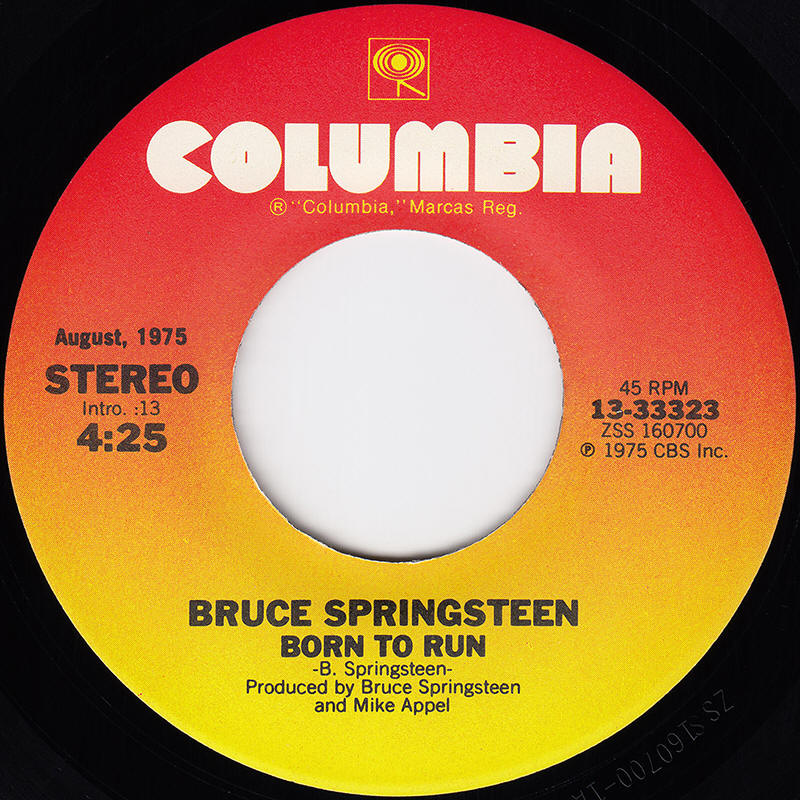 Just like it was no surprise that I drafted Born to Run as my fave all-time LP, there was never any doubt that its title track would be my pick for all-time favorite song. In fact, I believe that along with Bob Dylan’s “Like a Rolling Stone,” they are tied for the greatest rock anthems ever to blast the airwaves.
Just like it was no surprise that I drafted Born to Run as my fave all-time LP, there was never any doubt that its title track would be my pick for all-time favorite song. In fact, I believe that along with Bob Dylan’s “Like a Rolling Stone,” they are tied for the greatest rock anthems ever to blast the airwaves.
Bruce once said something along the lines of that when writing the song, he wanted to have music like Phil Spector, words like Dylan, and vocals like Roy Orbison. Well, he did just that and outdid himself with a song that to me is just perfect in every way.
The song couldn’t have come at a better time for his then fledgling young career. After two excellent records that went nowhere, Columbia Records were likely let to drop him if this one didn’t make it. And although he did score, oddly, while the LP reached #3 on the charts, the title track and obvious choice as first single, only made it to #23. But, still today, some 45 years later, I’m not the only super-Springsteen fan who considers it their favorite song from the Boss.
Living through this process with Springsteen is a fond memory that started with its early release to a few key radio stations that included my lock-on-the-dial at 102.7 of WNEW-FM in New York City. For a good while you could only hear it that way, and I’d didn’t even own a cassette deck to record it. Those moments of hearing it were the start of a magical summer that would culminate for me with the eventual release of the album shortly after seeing Bruce perform live for the first time at the legendary 1975 Bottom Line shows.
Over the course of the 60 Springsteen live shows I’ve seen, he’s played it every night except for the two solo acoustic Tom Joad tour shows I attended. I’ve even seen it solo acoustic, both on Broadway and on the Tunnel of Love tour. While I give Bruce a pass on Broadway, not seeing him blast it away during the encore with the full E Street Band was however a disappointment.
Hearing this song live has always been an amazing moment for me. Here’s what I had previously written about those experiences for the album draft:
I was a hopeful optimist like the Boss. These lines from that song just clobbered my emotions back then and for the next 40 years made me cry every time I heard Bruce sing them live.
Oh, someday girl, I don’t know when
We’re gonna get to that place
Where we really want to go, and we’ll walk in the sun
But ‘til then, tramps like us
Baby we were born to run
Those tears reflected the joy of seeing my lifelong dreams fulfilled. I found the girl I loved and together we took that walk and somehow got there.
About the song, it’s no secret that I’m a sucker for rock anthems which “Born to Run” clearly qualifies. Its music is just so powerful, from the opening drum burst to the crescendo of guitars and saxophone blasts. This is a song meant to hear while driving down the highway with the top down (or at least the windows open).
The words? Poetic for sure. And aside for the optimism I’ve already discussed, let’s not forget that I’m from Jersey and the references to “Highway 9” and “The Palace” (in Asbury Park) added a special personal touch.
In reflecting on my history with this song, I remembered a moment on some long-forgotten MTV game show whose name I can’t even recall. There was a question about what the greatest Rock song of all time and the contestant chose “Born to Run.” My “attaboy” was however soon shot down by guest host Alice Cooper who mocked his selection without any explanation. To this day, I’ve often wondered what bothered Alice about the song. Maybe someday I will get to ask him why he doesn’t agree with me that “Born to Run” is the greatest song of all time. Could be that he prefers “Like a Rolling Stone?”
#2. “(What’s So Funny ‘Bout) Peace, Love & Understanding” – Elvis Costello & the Attractions

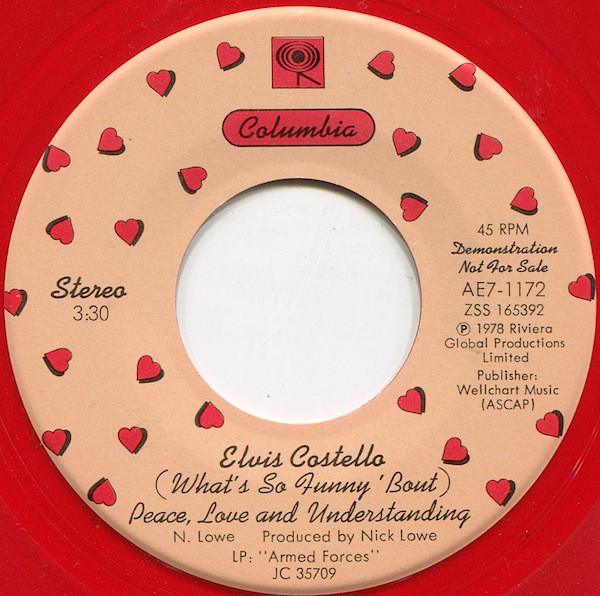 One of several traits that labels me a bona fide musical nerd is my love of making music-themed lists. In true High Fidelity fashion, I find great joy in behaving just like they did in the record store in the Nick Hornby book and John Cusack film.
One of several traits that labels me a bona fide musical nerd is my love of making music-themed lists. In true High Fidelity fashion, I find great joy in behaving just like they did in the record store in the Nick Hornby book and John Cusack film.
So, the fact that I maintain an on-going mental list of my favorite songs puts me right in the groove for this song draft. Of course, my song list is somewhat fluid and subject to change. But, for as long as the songs I have selected for my top two picks in this exercise have existed, they hands down have always taken the #1 and #2 spots.
Following my previous selection of Bruce Springsteen’s “Born to Run” as numero uno, my second selection also happens to be another anthem: Elvis Costello & the Attractions’ version of Nick Lowe’s “(What’s So Funny ‘Bout) Peace, Love & Understanding.” While there is no doubt that I find this song to be just incredibly irresistible, it also serves as a way of squeezing two of my favorite artists into my top ten amongst the fierce competition.
“PLU” as us Costello diehards call it, was originally recorded back in 1974 by Lowe’s former Pub Rock-era band, Brinsley Schwarz, of whom a young Costello was a huge fan. The Brinsley’s version was sung by Lowe in a rather subdued tempo and was a “tongue-in-cheek” poke at the Hippie peace and love movement. It wasn’t that he didn’t hold the sentiment, he was just having fun in going over the top with some cheeky lyrics.
Lowe of course later became Costello’s producer and five years later in 1979, the Elvis & the Attractions version of “PLU” was covertly released to the world as the B-side of the British Nick Lowe single for “American Squirm.” The song was even credited to “Nick Lowe & His Sound.” If you looked hard, you could find a blurry picture of Costello hiding in the clouds on the back of the sleeve. The song however would soon be loved enough that it was added to the US version of Costello’s Armed Forces LP. It also would get a single release in the US on a red vinyl promo 45 along with EC’s croon of “My Funny Valentine” on the flip side.
It is quite odd that my favorite song by one of our generation’s greatest songwriters is a cover and not one of his originals. (Strange too that Costello’s best-selling UK single is his take on the George Jones chestnut “Good Year for the Roses.”) But dang, the Attractions arrangement of “PLU” is just over-the-top powerful and amazing! In fact, it’s so darn good that Mr. Lowe himself adapted his live version of the song to sound more like Costello’s take on it. Nick even jokes that he forgets sometimes that it is his song!
While I truly savor the song’s sentiment and adore the lyrics, it’s undoubtedly the mighty musical arrangement that does it for me. And thankfully I’ve gotten the opportunity to stand many times pumping my fist in the air while hearing the song at a Costello show, usually as one of the night’s final numbers.
Something that will make a song a classic as this one truly qualifies, is when it gets repeatedly covered by other artists. (In this case is it a cover of a cover that is getting covered?) The list of “PLU” covers is a long one from Midnight Oil to Wilco and the dozens of other artists who have either recorded their version of the song or played it in their live set. One notable version is by singer Curtis Stigers on the The Bodyguard soundtrack LP which reportedly made enough quid for Mr. Lowe (reportedly over a million pounds) to continue with his musical activities when times were lean.
Finally, the moment I got to miss was one of the dozen times in 2003-4 when Bruce and the E Street Band gave the song a whirl. Maybe someday, worlds will once again collide, and I will be there to hear my three favorite artists represented in a single moment.
#3. “Up the Junction” – Squeeze

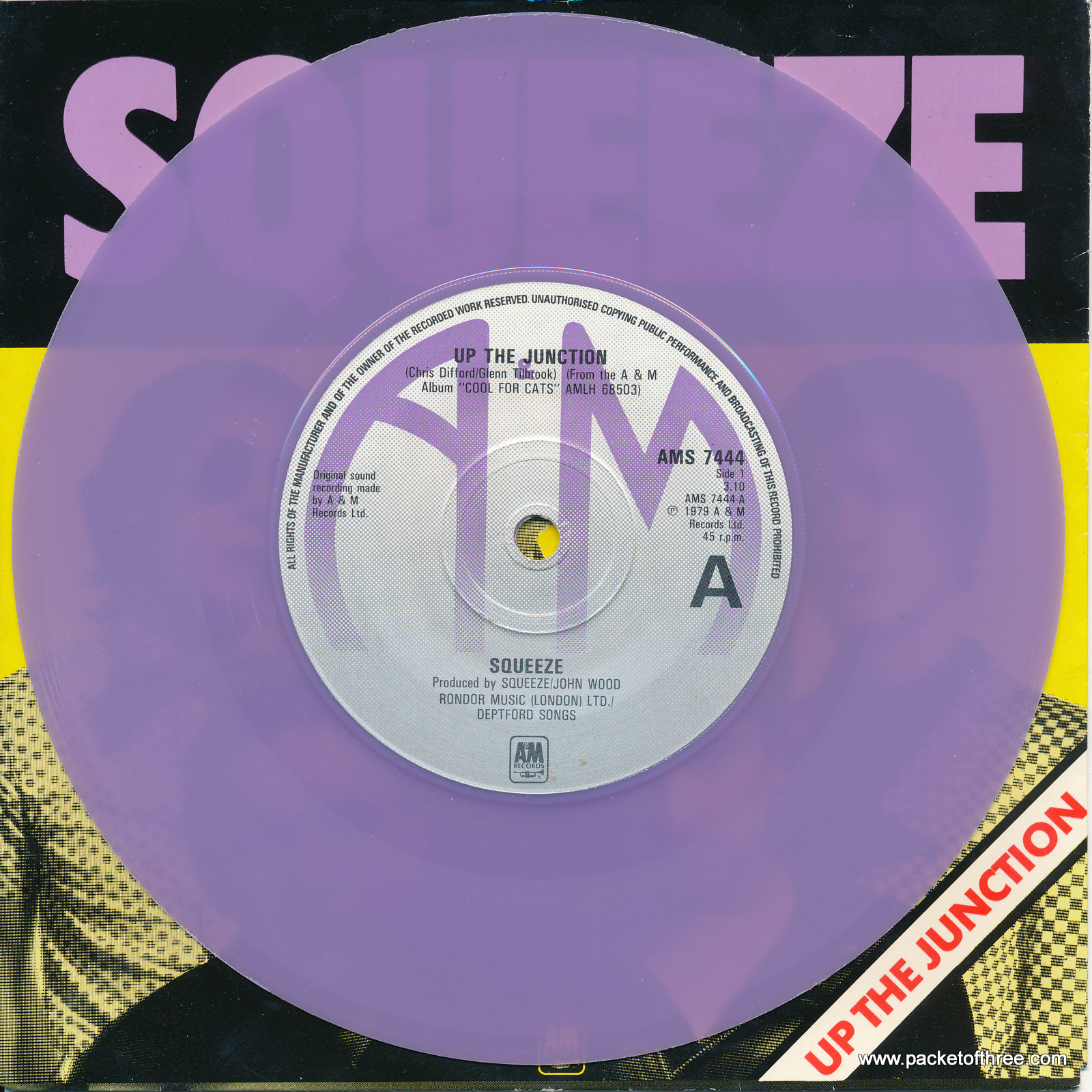 How can a Pop song of seven unique verses, without a chorus, and lyrics that don’t reveal the song’s title until the final words, be so infectiously brilliant? Well, like other great works from the songwriting partnership of Squeeze’s Chris Difford and Glenn Tilbrook, 1979’s “Up the Junction” has an instantly recognizable riff, a fab melody, and words that you just can’t resist singing along to.
How can a Pop song of seven unique verses, without a chorus, and lyrics that don’t reveal the song’s title until the final words, be so infectiously brilliant? Well, like other great works from the songwriting partnership of Squeeze’s Chris Difford and Glenn Tilbrook, 1979’s “Up the Junction” has an instantly recognizable riff, a fab melody, and words that you just can’t resist singing along to.
The Difford and Tilbrook work routine has always baffled me. It just boggles my mind how Tilbrook can so perfectly write music to Difford’s words without the two working together at the same time. “Up the Junction” is just one of many fine examples of their skills and was Chris’s first of several narrative tales he has penned. According to Glenn, “There’s no chorus because I thought a repeated section would spoil the flow of Chris’s story.”
“Up the Junction” was the third single from the band’s second LP, Cool for Cats, and made it all the way to #2 on the UK charts. Although it is much adored by fans in the US, it was perhaps too British to make a dent sales wise as a single in America and was not released as such.
Love for the song did get a big boost in the States in 1982 with the release of the Singles – 45’s and Under compilation LP. This platinum-selling collection of Squeeze’s singles was a smash over here and helped the band expand it’s following by re-introducing some of the earlier songs that American fans may have missed. After getting more notice after their release of “Tempted,” earlier in 1982, the band even headlined a gig at New York City’s Madison Square Garden. And, in an odd turn of events, the band would call it quits for a few years after finishing this major tour.
“Junction” is such a lovely song to learn every word and sing along to. Its tale tells the love story of a young couple that turns sad rather quickly. I’m sure many other fellow Americans like me found much of the song’s charm in all the new British slang we learned from the song’s lyrics.
Starting with the title, the phrase, “up the junction” means to be in deep trouble. It also refers to Clapham Junction where the “girl from” in the song hails. What other words did we discover from this song? Windy Common? Telly? Tenner? Nifty? Nappies?
I am writing this only a week after having seen Squeeze play live and “Up the Junction” was, as always, a highlight in the set for all. Hearing “Junction” in concert is a joyous three-minute sing-along. In the current live version, band member Melvin Duffy adds a new twist to the song’s music playing the familiar lead riff on pedal steel. In the past, I’ve also loved Tilbrook’s solo acoustic version of the song, especially the percussive intro that he bangs out on the wood of his acoustic guitar, mimicking the song’s opening drum rap.
Now here’s something that you might not know, some 20 years later, Difford wrote a sequel song called “A Moving Story” for 1998’s somewhat forgotten LP, Domino. While this song may not match the original’s charm and success, Chris got to update the sad saga of “Up the Junction” saying, “I thought they deserved a happy ending.”
#4. “Electric Guitars” – Prefab Sprout
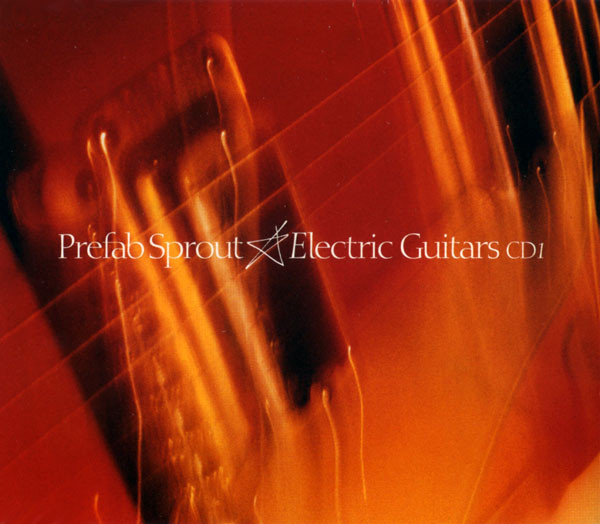 A friend and I once had a discussion about “Perfect Pop Songs.” Without even defining what constituted such a thing, we both started ratting off titles and acknowledging agreement with each other’s selections. (I will save the list for another time.) It didn’t take me long however to call out the Pop perfection of the 1997 song “Electric Guitars” by the British band, Prefab Sprout.
A friend and I once had a discussion about “Perfect Pop Songs.” Without even defining what constituted such a thing, we both started ratting off titles and acknowledging agreement with each other’s selections. (I will save the list for another time.) It didn’t take me long however to call out the Pop perfection of the 1997 song “Electric Guitars” by the British band, Prefab Sprout.
Listen to the song and you will hear what defines our undefined criteria. It’s a short song (3:41) with an easy-to-grasp message by way of simple concise lyrics set to a memorable melody. Not a single word is wasted and there are only two stanzas and a repeated chorus. The lyrics are so well-crafted that you love hearing that refrain repeatedly sung. You soon learn every word and can sing along and recreate the complete musical experience note-for-note in your head.
For the unfamiliar, Prefab Sprout is the vehicle for the brilliant singer-songwriter Paddy McAloon. “Electric Guitars” was the opening track on Andromeda Heights, the sixth Sprout LP and a favorite of many of the band’s devoted fanbase. The album hit the #7 spot on the UK charts but got nowhere here in the US. “Electric Guitars” was released in the UK as the LP’s second single but only made it as far as a disappointing #53.
The song is about having “a dream that we were rock stars.” Whether Paddy is singing about his band really doesn’t matter since this is a dream that we all can relate to. The “hysteria-a-go-go” he writes about places his “we” on the Beatles side of a joyful Beatlemania, even finding them “quoted out of context.” What he is singing about sure sounds like a great place to be. There is an interesting turn later in the song when the opening verse gets repeated with the twist that this wasn’t a dream at all!
Oddly, although there is a somewhat subdued electric guitar riffed throughout the song, the title is somewhat misleading as “electric guitars” are by no means the song’s musical focus. In fact, my then-teenage son once arranged and played a gorgeous piano version of the song that just floored me when I heard it. A telling testament to “Electric Guitars” Pop perfection.
Another thing I love about the song is how the ending of the verse overlaps with the beginning of the chorus through a studio overdub. This always makes me stumble when I sing along, either picking one word over the other, or revising the arrangement with a full stop as if I were singing on stage and had no alternative.
Paddy also stars in a humorous video for the song which features portrayals of some real “rock stars” who are known for playing their electric guitars.
My love for Prefab Spout is strong and one thing that I never tire of is Paddy McAloon’s beautiful singing voice and “Electric Guitars” features him at his best. It surprises me that the song is not more well-known as well as not more admired by the Prefab faithful. Nonetheless, I make my love for it no secret and quite often listen to it on multiple repeats. Now, if only I could get my son, now grown, to record me his piano version.
#5. “Can’t Hardly Wait” – The Replacements

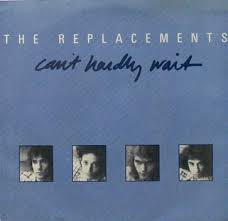 There are times, when despite the disapproval of the band, a producer gets his way and adds something to a song that really works. Case in point is the 1987 Pleased to Meet Me LP version of The Replacements’ “Can’t Hardly Wait.” The song began as nothing more than a few seemingly unrelated scraps of Paul Westerberg lyrics set to a catchy guitar riff that runs from beginning to end. However, the “Memphisized” horns and strings embellishment added by producer Jim Dickinson simply took this song to another level.
There are times, when despite the disapproval of the band, a producer gets his way and adds something to a song that really works. Case in point is the 1987 Pleased to Meet Me LP version of The Replacements’ “Can’t Hardly Wait.” The song began as nothing more than a few seemingly unrelated scraps of Paul Westerberg lyrics set to a catchy guitar riff that runs from beginning to end. However, the “Memphisized” horns and strings embellishment added by producer Jim Dickinson simply took this song to another level.
Through the wonder of bonus tracks, we got to hear an earlier version of the song that was originally recorded for 1985’s Tim LP. Guitar driven and faster, this leaner take on the song also had different lyrics. Choosing which version is better is a topic of strong debate among “Mats’” fans, and I know that many will stop reading this piece right now in protest of my selection. But for me, Dickinson’s touch on “Can’t Hardly Wait” was magic. To the contrary, Westerberg was said to have been reluctantly OK with the horns but hated the strings.
The song’s greatness was later acknowledged by a remarkable arrangement from the late Justin Townes Earle. That iconic guitar riff was well-suited for JT’s fingerpicking style, and he created a cover version that gives this song an acknowledged acoustic alter-ego.
Meet Me was the break-through Replacements’ record for me. It saw the band steer more to a Pop style which made their sound more mature (an awful, but somehow fitting word) and accessible to fans with musical tastes like mine. Still, Paul’s lyrics still found a way to be lovingly snarky and cynical.
“Jesus rides beside me, he never buys any smokes” is just one of the greatest lines ever! It never fails to crack me up, and I go back and forth between picturing either the Son of God or a Hispanic friend of Westerberg’s as the cheap passenger. Outside of this and some silliness about being too wasted to write a letter, that’s about all there is besides the chorus and the repetition of the title near the song’s end. That’s all that was needed.
Some record company person liked the song enough to release it as a single and of course it went nowhere on the charts. “I Can’t Hardly Wait” sure deserved a better fate. I challenge you. Go put it on and after your second listening, if you are sitting still or at least not tapping your feet, go see a doctor.
Oh, and by the way, Westerberg changed his tune a bit and when performing the song on Saturday Night Live in 1993 as a solo artist, he used a horn section! No strings, but I bet this made the late Jim Dickinson smile.
#6. “You Get What You Give” – New Radicals
 I’ve never had the chance to meet Joni Mitchell, But, if I ever do, the first thing we are going to talk about is our mutual love for the 1998 song, “You Get What You Give” by one-LP wonders New Radicals. In fact, Ms. Mitchell loved the song so much, that in a 2000 Q&A with Rolling Stone, she said that it kept her from quitting music all together. Fast forwarding to 2017, knowing what Joni had said, journalist Roger Friedman introduced her to the Radical’s Gregg Alexander, the man behind this great song, making for a moment he will never forget.
I’ve never had the chance to meet Joni Mitchell, But, if I ever do, the first thing we are going to talk about is our mutual love for the 1998 song, “You Get What You Give” by one-LP wonders New Radicals. In fact, Ms. Mitchell loved the song so much, that in a 2000 Q&A with Rolling Stone, she said that it kept her from quitting music all together. Fast forwarding to 2017, knowing what Joni had said, journalist Roger Friedman introduced her to the Radical’s Gregg Alexander, the man behind this great song, making for a moment he will never forget.
As for myself, the song has brought me great joy and I credit the “never afraid to play new music” Nashville radio station Lightning 100 for introducing me to it. Although, it was quite funny that it took several airings for me to actually catch the DJ identifying who the artist behind this instantly catchy anthem was. My best guess until I learned the truth was that it was a new Todd Rundgren song.
There is another funny “You Get What You Give” memory for me After securing a copy of the lone New Radical’s record, Maybe You’ve Been Brainwashed Too (a CD on MCA), I of course played that song to death around the house, usually dancing wildly and singing loudly. Later, my wife would tell me that one day while shopping with our young kids at the grocery store, it played over the PA and one of the boys said “Listen, it’s Daddy’s song!”
New Radicals were essentially just Gregg Alexander with some help from former child-actress Danielle Brisebois and various session musicians. Alexander had previously released a pair of solo records that went nowhere, and after this LP, the Radicals were no more although Gregg has continued as a successful songwriter. He did assemble a band and toured for Brainwashed although yours truly never got a chance to see them.
“You Get What You Give” is a remarkable full-sounding song that is built on several musical layers. Co-written with successful songwriter Rick Nowels, it starts slowly with some musical tinkling and then just explodes after Alexander calls us to attention and counts down. Then it’s no turning back from its powerful driving sound, lyrics and chorus that just envelop your total senses. Throughout its entire five minutes, the song doesn’t give the listener a moment of rest. The message is positive and uplifting with an encouraging cry of hope, but the real raw power comes from Alexander’s snarking at a few negatives as the song closes.
As for those negatives, how’s this for some great snark:
Health insurance, rip off lying
FDA, big bankers buying
Fake computer crashes dining
Cloning while they’re multiplying
Fashion shoots with Beck and Hanson
Courtney Love and Marilyn Manson
You’re all fakes
Run to your mansions
Come around, we’ll kick your asses
Given that it’s a complex song masterfully produced by Alexander, I wondered how its Phil Spector-ish “Wall of Sound” would come off live. Although I’ve not come across any live recordings, there are a few television performances on YouTube that I think pass the test. Gregg, Danielle, and the musicians also reunited 22 years later to perform a great lively version at the Biden inauguration. However, it was sanitized to omit those classic snarky closing lines. In some interviews, Alexander expressed some regret about picking on those folks like he did, and I guess that this was also an occasion to look beyond any negativity.
“You Get What You Give” charted number one in Canada and New Zealand and made the top 40 in both the US (#35) and the UK (#5). As for the rest of the LP, there’s only one other great track that keeps the Radical’s from being a one-hit wonder. “Someday We’ll Know” is a gorgeous ballad later covered by Hall & Oates that deserves a listen as well if you don’t know it.
In this crazy, often stupid world that we find ourselves in, the optimism in this song still rings true:
You’ve got the music in you
Don’t let go
You’ve got the music in you
One dance left
This world is gonna pull through
Don’t give up
You’ve got a reason to live
Can’t forget
We only get what we give
Putting hope aside for a minute, I could only imagine what new snark an updated version of the song at the Biden bash would have had. Well, whatever it would have been, I’m sure both Joni and I would have loved it.
#7. “She’s Gone” – Daryl Hall & John Oates
 One great song alone doesn’t make a great album. But the best LPs do sometimes feature one that becomes a classic. Thus far in this song draft, “She’s Gone” by Daryl Hall & John Oates, marks the third that has come from an album that was in my top ten from that previous series. While I welcome bringing some variety to the table by selecting songs from LPs not in my top ten, these three were simply too special to me to not be chosen.
One great song alone doesn’t make a great album. But the best LPs do sometimes feature one that becomes a classic. Thus far in this song draft, “She’s Gone” by Daryl Hall & John Oates, marks the third that has come from an album that was in my top ten from that previous series. While I welcome bringing some variety to the table by selecting songs from LPs not in my top ten, these three were simply too special to me to not be chosen.
“She’s Gone” is a timelessly perfect soul ballad that was the single from Daryl Hall & John Oates’ 1973 Atlantic Records album Abandoned Luncheonette. At the time of its release, the song got good airplay and became a “regional” hit in the New York area and of course their hometown of Philadelphia. However, it was brutally apparent to most all who heard it that this just was not fair, and that “She’s Gone” deserved much more than that, only getting as far as #60 nationally on the Hot 100 single charts. This fact was recognized by the soul band Tavares who in 1974 took their version of the song to #1 on the R&B charts, although only reaching 10 spots higher than the duo did on the Hot 100.
But, when Hall & Oates received greater acclaim for the song “Sara Smile” three years later on RCA Records, the folks at Atlantic knew that were still sitting on a gem and in 1976 rereleased “She’s Gone” as a single. Well, the third time was the charm (if you count the Tavares cover) and the song went all the way to #7 on the Hot 100, helping shape the song into the radio classic that it is today.
Of course, a great song needs great lyrics and Daryl and John put some together penning “She’s Gone” at a time when both were going through breakups. They paint a real-life picture of the sad situation that most, if not all of us, have had the misfortune of finding ourselves in. And this song doesn’t even turn around to have a happy ending! Witness Hall singing lines like “I better learn how to face it” and “I’d pay the devil to replace her.”
One lonely scene of loss the song pictures that has always been my favorite is in the line “I’m worn as her toothbrush hangin’ in the stand.” At first, I misunderstood it to be “One less toothbrush hangin’ in the stand” which would also have been a great line! (Fledgling songwriters – feel free to take it!)
But, as much as we all love words, a song ain’t going nowhere on the charts or into the kingdom of classics without a great performance. For “She’s Gone,” proof of that only requires one listen. Both Hall’s lead vocal and Oates shadowing vocals are over-the-top brilliant. (And they still sublimely sing it today, almost 50 years later!) And the song’s arrangement by legendary producer Arif Mardin is so perfect, that changing a single note would be like painting a moustache on the Mona Lisa.
Hands down, “She’s Gone” is my favorite song of all time to sing along to. In the shower, in the car, I’ve probably sang it nearly as often as the boys play it in concert. So, listen to it and learn it, and I promise that you will love it like I do. And by all means, go see Hall & Oates while you still can because seeing them sing it live on stage is one performance you don’t want to say you never got to see.
#8. “I’m Not in Love” – 10cc
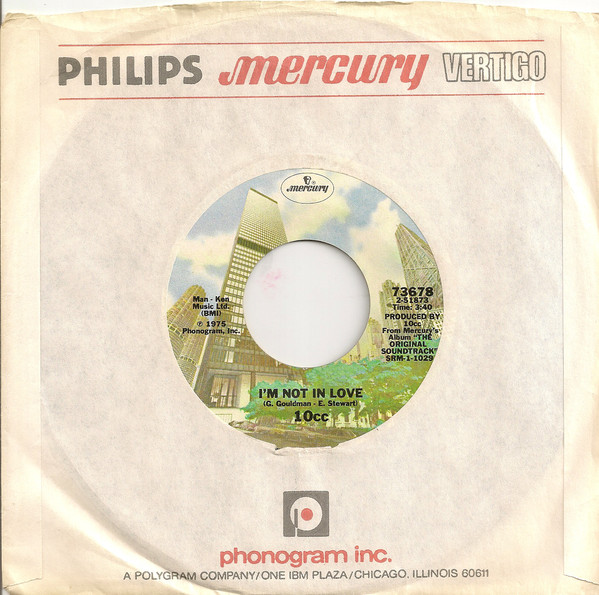 Although I’m a novice to the art, I once made a perfect Karaoke score singing 10cc’s “I’m Not in Love.” And although it didn’t get me any bonus points, I even inserted the “Be quiet. Big boys don’t cry” bit. In retrospect, this experience revealed two things: (1) I can’t sing and (2) I really love this song. Now, in this crazy divided world of ours, can we all at least agree that this British band’s 1975 hit is a delightfully brilliant perfect Pop song?
Although I’m a novice to the art, I once made a perfect Karaoke score singing 10cc’s “I’m Not in Love.” And although it didn’t get me any bonus points, I even inserted the “Be quiet. Big boys don’t cry” bit. In retrospect, this experience revealed two things: (1) I can’t sing and (2) I really love this song. Now, in this crazy divided world of ours, can we all at least agree that this British band’s 1975 hit is a delightfully brilliant perfect Pop song?
Yours truly had fallen hard for 10cc’s eponymous 1973 debut LP, which of course made my previous Top 10 LP list. I was even blessed to see the band play live at a tiny club in New Jersey when they were still under most American music fan’s radar screens. Looking back, I’m still not sure while I was slightly distracted from their fantastic sophomore LP, Sheet Music. However, 10cc’s 1975 follow-up, The Original Soundtrack, was hard for me to ignore, especially after hearing “I’m Not in Love”
The song was composed by the “Pop” half of the 10cc quartet, Eric Stewart and Graham Gouldman. But it took input from the other half of the band, the more Art and Techno driven Lol Crème and Kevin Godley to make “I’m Not in Love” the masterpiece it became. Godley flat-out hated what he had heard and creatively suggested that they abandon its original Bossa Nova arrangement and instead use a backing track consisting of their multi-layered vocals. This clever trick worked and took “I’m Not in Love” to the top spot of the UK singles chart and into the Top Ten in the US.
There is an illustration of the process behind Godley’s idea that through studio wizardry, created a “choir” of 48 voices in the BBC Special about 10cc which can be viewed on YouTube. (Here’s a link to that excerpt about the making of this song.) Besides these voices, the song has little other instrumentation in its composition. A truly remarkable creation!
The entire song just sounds gorgeous. Stewart’s lead vocal is completely void of emotion and is a perfect fit to the cynical lyrics in which the song’s narrator denies that certain things are exhibits of the love he claims he is not in. The best by far is the one about his “not-love’s” picture hanging on the wall only to hide a nasty stain.
As was usual back then, the LP version got chopped down from 6:04 to 3:42 to be more suitable for radio play. I of course prefer the full deal.
In addition to being a hit at the time, history has been kind to 10cc’s “I’m Not in Love” with the song appearing in several movie soundtracks. Without a doubt, its most famous appearance is the one on the “Awesome Mixtape” belonging to actor Chris Pratt’s character in Guardians of the Galaxy.
There also have surprisingly been several cover versions of the song, each I’m sure of which Godley said “It’s crap” like he said after hearing the original 10cc version. To me, the sonic wonder of 10cc’s original simply can’t be recreated!
#9. “Tangled Up in Blue” – Bob Dylan
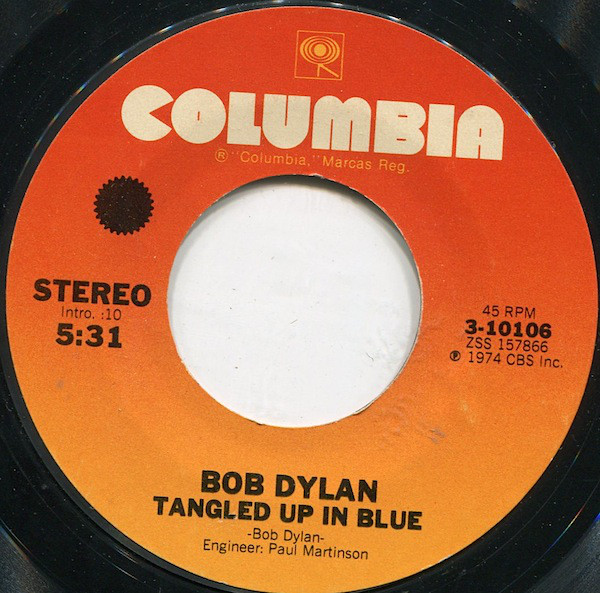 While I will readily acknowledge that “Tangled Up in Blue,” the opening track from his 1975 LP Blood on the Tracks, may not be his Bobness’ greatest song, it’s certainly in his top ten where “Like a Rolling Stone” sits at #1. But “Tangled” is by far my favorite Dylan tune. It likely holds that spot since the LP it comes from was the first one released that I savored in real time. Blood on the Tracks on 8-track tape was played an awful lot in my 1971 lime green Ford Pinto while I commuted to college back then.
While I will readily acknowledge that “Tangled Up in Blue,” the opening track from his 1975 LP Blood on the Tracks, may not be his Bobness’ greatest song, it’s certainly in his top ten where “Like a Rolling Stone” sits at #1. But “Tangled” is by far my favorite Dylan tune. It likely holds that spot since the LP it comes from was the first one released that I savored in real time. Blood on the Tracks on 8-track tape was played an awful lot in my 1971 lime green Ford Pinto while I commuted to college back then.
Although Bob had recently split with his wife Sara, Mr. Dylan has often said that Blood on the Tracks was not autobiographical despite it being a “break-up” record. But some of its tale does seem to fit his life, and when listening to “Tangled Up in Blue” and getting lost in the cinematic imagery of its narrative, it sure is Dylan that I picture. He did try to confuse things though when in later live versions, revised lyrics often changed the song’s main character from first person (“I”) to third (both “He” and “She”).
The lively upbeat acoustic tempo of the song has always made it a fun sing-along for me. It’s a delightful story to follow and again, Dylan delivers lyrics like few can. Something though that it took time for me to notice was that the storyline within the song is non-linear, like is often found in many novels.
Surprisingly, despite being a little long for the radio at 5:41, “Tangled Up in Blue” was released as a single and even made it to #31 on the US charts. It also was one of the songs that Dylan re-recorded with the “Minneapolis Musicians” after it had been previously cut in New York City with some session players. It also was produced by Bob’s brother, David Zimmerman, although he is not credited.
What’s my favorite segment of the song, you ask? Well, that must be when “She was working in a topless place and I stopped in for a beer.” And it’s all because of the curious scene that this spot’s closing lines portray: “I must admit I felt a little uneasy when she bent down to tie the laces of my shoe.”
Finally, to me it’s truly remarkable how in this song, Dylan gives form and substance to the word “blue.” He was once quoted as saying that he was inspired by Joni Mitchell’s 1971 album, Blue. To me, the song gives the word “blue” the character of a state of mind or an obstacle to overcome. But I’ll leave the “Dylan-alysis” to the professionals and just say that regardless of his intentions, I just love the whole story!
And this live video of Dylan performing the song on his 1976 Rolling Thunder Revue is one of my fave live clips of all time. Watch, enjoy and sing along!
#10. “Starry Eyes” – The Records
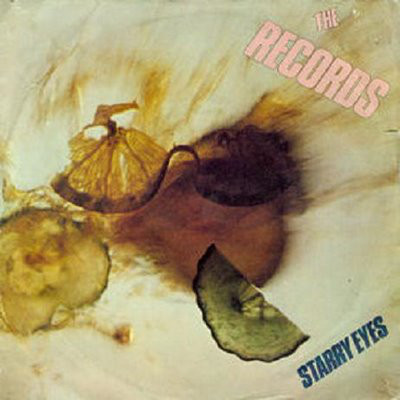
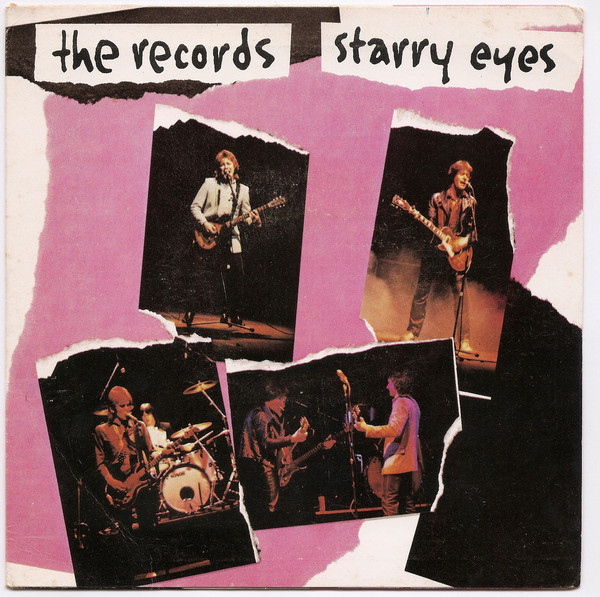 Limiting myself to only ten favorite songs is simply not enough, and I am thankful that the proprietor of this project will be soon letting us draft another ten. And as I mentioned previously, it seems that many of my initial ten tunes are found on my top ten album selections. Well, this one does too, and I suggest that you first read my piece on the debut LP by England’s The Records before reading me gloat about this song here.
Limiting myself to only ten favorite songs is simply not enough, and I am thankful that the proprietor of this project will be soon letting us draft another ten. And as I mentioned previously, it seems that many of my initial ten tunes are found on my top ten album selections. Well, this one does too, and I suggest that you first read my piece on the debut LP by England’s The Records before reading me gloat about this song here.
Nonetheless, I will briefly say that I had I had the distinction of hearing The Record’s 1979 debut single “Starry Eyes” for the first time, live in concert. It was love at first listen. Being a Power Pop junkie, it powerfully popped my musical sweet spot.
Like any great Power Pop song, “Starry Eyes” starts off with an incredible unique guitar riff, this one by band member Huw Gower. It’s one of my favorite song intros of all time and is one that certainly gets your attention. It’s also not an easy riff to play, and Gower really guts this one out.
But unlike most great songs of the genre, it’s not a love song! Rather it’s about the nasty business side of music and is an ode to a sinister music biz weasel. Yes, it’s a rough trade and its co-author, Will Burch previously the drummer with Pub Rockers, The Kursaal Flyers, has said that the song is about a former manager.
Mr. Burch is now a respected music journalist and he co-wrote “Starry Eyes” with the band’s lead vocalist, the late John Wicks. Lyrically brilliant, the song likens a business breakup to a romantic one. Check these lines out:
First there’s the separation:
While you were off in France, we were stranded in the British Isles
Left to fall apart amongst your passports and your files
Then there’s the money:
While you were on the beach
Were you dreaming all about your share?
Then a chance at resolution:
I don’t want to argue, I ain’t gonna budge
Won’t you take this number down before you call up the judge?
But finally, it’s over:
I don’t want to argue, there’s nothing to say
Get me out of your starry eyes and be on your way
“Starry Eyes” was first released in the UK as a single but was later replaced on the British LP with an “album” version that was a tad longer. More so than that, the two versions are notably different in their performance and there is an additional lyric in the repeated chorus of the album version. While both takes hold up well, I prefer the “single version” which is slightly faster and sounds crisper, especially for Gower’s guitar intro. Here in the Colonies, the folks at Virgin Records agreed and used the original shorter version on the US LP. Said single was more loved on the left side of the pond and made it up to #41 on the US Singles Charts.
When my time in this world is one day over, the great song counter in Heaven will undoubtedly show that “Starry Eyes” is the one that I have listened to most in my lifetime. And until then, its plays will keep adding up as this is one song that never fails to pep me up!
